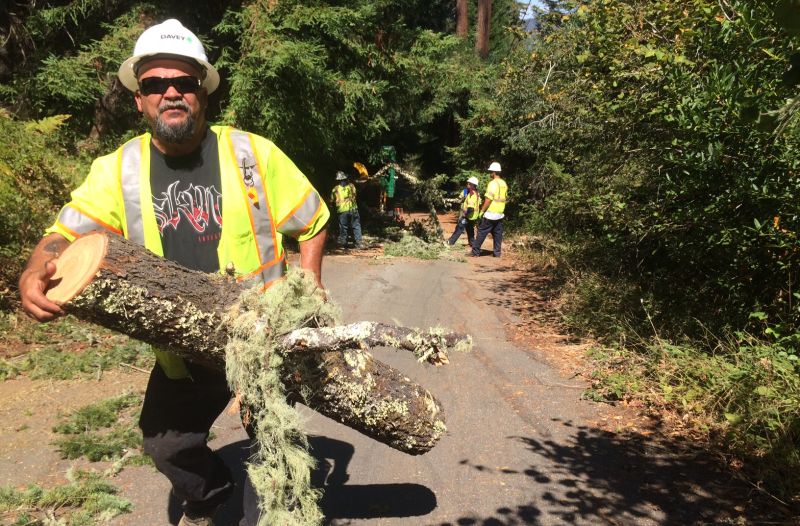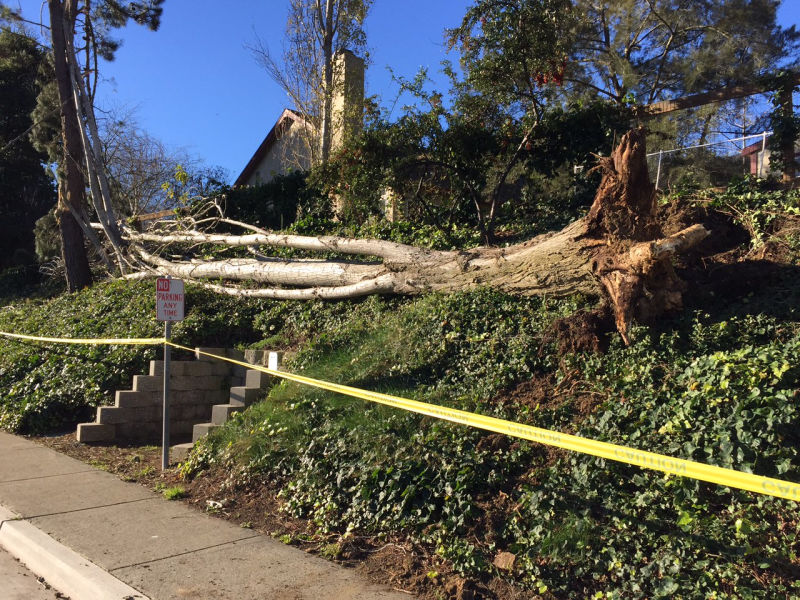Listen to the story:
Drought-Weakened Trees Could Pose Danger This Winter

Drought-Weakened Trees Could Pose Danger This Winter
After four years of drought, California has a huge number of dead and dying trees.
After a U.S. Forest Service aerial survey last spring, researchers estimated there were 12.5 million dead trees on national forest lands alone.
That doesn’t count dead and dying trees in open spaces and urban parks, or on private property like your backyard or your neighbor’s.
With climatologists predicting that this year’s El Niño will usher in strong winds and torrential rains, weakened trees pose dangers to people and property across the state.
In the Bay Area, arborists are working overtime to prune or remove trees on private property. And many homeowners aren’t receiving any assistance with the cost; San Francisco, Oakland and Berkeley don’t have funds designated for this. In San Francisco, even street trees — normally a municipal responsibility — are being turned over to residents because the city doesn’t have the money to manage them.
Protecting Power Lines
PG&E inspects millions of trees each year and is responsible for removing limbs and trees that pose a threat to power lines in urban and rural areas.
On a work site in Santa Cruz recently, program manager Joel Smith points out the signs of a dead tree, a Douglas fir that crews are trimming.
“There’s just a small portion of green up toward the top,” he says, “and the rest of the crown is basically dead.”
Clumps of pine needles at the top of this Douglas fir have started to turn brown, and lichen hangs from the lower branches. Smith says this tree is too close to power lines.
To get a sense of the size of this tree, look for the PG&E crew member who’s barely visible, just under the branch that’s being trimmed off.
“It is very serious,” he says. “Trees that are dead or are otherwise compromised can fail, and if they are close to our high voltage lines they can cause those lines to come down, which can create a very dangerous public safety hazard, as well as taking out the power and potentially causing a wildfire.”
Cal Fire officials are currently investigating whether this month’s devastating Butte Fire was ignited when a tree came into contact with a power line.
This year, says PG&E, crews are taking out 30 percent more dead trees and twice as many hazardous trees as in a non-drought year. And when customers call for a tree inspection, crews are doing less pruning and more removal.
What Should Homeowners Do?
If you see a drought-stressed tree near a power line, call PG&E; if it’s a street tree, call 311 to schedule a city inspection. But if you’re worried about a tree on your property, call a certified arborist.
Remy Hummer with Arborist Now says he’s been working overtime since the beginning of the year, trimming and removing trees or supporting them with cables. He says a lot of calls this fall are from homeowners worried about storms.

“If we’re going to incur any sort of storm, there’s going to be a lot of trees in jeopardy,” he says, “even the ones that are very sound.”
San Francisco officials say even in an ordinary year, between one and three tree branches fall every week in the city.
But U.C. Berkeley forest ecologist Joe McBride says this winter, hundreds of branches could fall every week.
Climatologists now say there’s a 95 percent chance El Niño will last through the winter. And they’re saying the storms could be as big as the El Niño of 1997-98, when San Francisco received double its normal amount of rain.
One clue that you may have a drought-stressed tree is a brown crown, says McBride. He says the crown is often the first place to go dry, because the tree simply can’t send enough water up to the taller branches.
A Bad Storm
In his four decades studying trees, McBride says one of the worst winter storms he remembers was in 1991.
“There were record wind velocities following about a week of rainfall in San Francisco,” he says, “and an estimated 6,000 trees at the Presidio and in Golden Gate Park were blown over as a result of that.”
And it didn’t take long.
“It all occurred in about a period of six hours, this one really heavy windstorm,” he says. “Blocked streets, a number of structures were hit by falling trees, cars were hit. It was a major disaster.”
It was a somewhat rare combination of prolonged rainfall with record winds, McBride says. And as to whether something similar is possible this winter?
“Oh, I think it’s possible,” he says, “yeah.”
